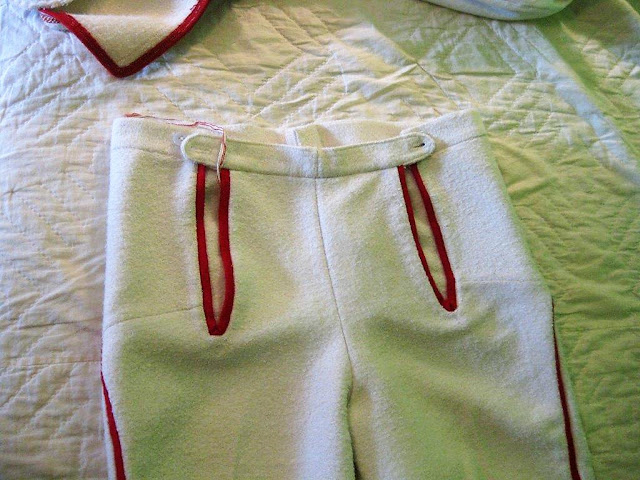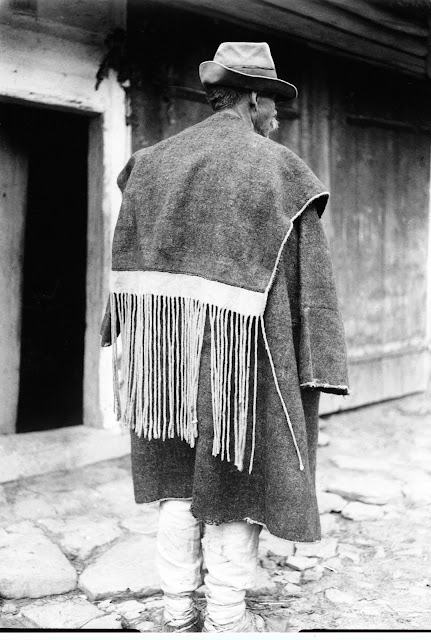Hello all,
Today I will present more information on the Central Lemko costume, focusing on the men. I will be talking about the same area as in the last article.
The image above is a family from the village of Vil'khovets' - Вільховець, Olchowiec in Polish
You may have noticed in my last article that while the women were in traditional costume, many of the men were in modern suits. This makes research into men's costumes more difficult.
When Reinfuss was travelling this area he made much of the fact that the older men's shirts, at least dress shirts, opened in the back, rather than the front. He thought this very strange.
They featured smocking on the back and some minimal embroidery on the collar. It was held closed with a red ribbon in young men, and just cord in older men.
Here are closeups of a couple of his photographs where you can see that the opening is not in front.
You can see the end of the red ribbon drifting across his shoulder.
Here is a closeup of the photo at the head of the article.
This man is from the village of Volovets’ - Воловець, Wolowiec in Polish.
Here is a piece which is now in a museum in Cleveland.
Later the shirt had the opening in front, but was unremarkable, being of plain white linen, a small fold over collar and full sleeves gathered into a cuff.
This photo is from the village of Rychwald - Рихвальд near Gorlice.
Later still, men desired more color, and had embroidery placed on their shirts in the Ukrainian manner, generally using polychrome cross stitch designs similar to those of the Boikos. This is now very popular among performing groups. They also added other decorations with no basis in traditional clothing.
The pants were of two kinds, for summer they were plain narrow legged pants of linen, which were unadorned. They had one opening on the center seam.
Here is our young friend from Vyshovatka again.
There is an opening in the center front, and he is wearing a belt with it. Notice that the cuffs of his shirt are also secured with a red ribbon.
For cooler weather, hard work or sometimes for dress, heavy wool pants made of sukno were worn over the linen ones, which were similar to those of the Gorals. These are called nohawky. They had one or two front openings, which typically were minimally adorned. There was often a slit on the outer seam at the lower leg.
This man is from the village of Kviaton’ - Квятонь, or Kwiatoń in Polish.
Here is a pair of pants from a contemporary performing group. This is a modern stage interpretation of the pants seen above. This example is made of cloth which is much lighter and more supple than the originals. Note that the originals were held up by a rope or belt which passed through a casing around the waist. These were made to close with buttons which is not traditional.
Over this was worn a vest called leibek. This is generally of blue wool, and is adorned with a variable number and placement of buttons.
Like the vests worn by the Silesian Gorals, the men's vests in this region generally did not actually overlap or close. However there were buttons on either side, and the vest was secured by one or more tabs made of wool or leather with a buttonhole on either end. One of my sources tells me that two rows of buttons were put on the front for courting young men, and only one row on each side for married men. Some of the photos which I have do not seem to follow this.
Take another look at the man from Volovets', here sitting next to his mother, I assume.
Here is a man from Radotsyna - Радоцина, in Polish Radocyna.
Here is an example from the village of Lypovets’ or Lypivets' - Липовець, in Polish Lipowiec, near Cheremkha.
Here is an example from the village of Bortne - Бортне, in Polish Bartne.
One should be wary of assigning excessive uniformity to traditional attire, however. There were always variations. For example, these men from the village of Vysova - Висова, in Polish Wysowa-Zdrój, who are clearly wearing double breasted vests.
Traditional footwear was moccasins over wrapped footcloths, lychaky, generally with cords or leather straps wound around the lower legs over the pants.
Exceptionally, boots were worn by those who could afford them, generally bought from Hungarian bootmakers in Slovakia. Later leather shoes also came to be worn.
Look at the various images in this article.
Outer garments were of two major kinds. The first is a short jacket of sukno, generally called hunia or hun'ka. These were of natural wool, usually dark, but sometimes light colored, as above. The light colored ones were more typical of the western part of this region. They were trimmed with contrasting cord.
This example is from the village of Bodnarka.
This man is from the village of Hrab - Граб, in Polish Grab.
And let's take another look at our friend from Volovets'.
I believe that this one is a modern reconstruction. The wool is thinner and softer than those seen above.
There was also a long outer mantle called Chuha or Chuhania which is distinctive to the Lemko people. This garment was also worn by some Western Boikos. Among the Polish it was unknown except for the Pogorzanie, who lived immediately north of the Lemkos. The Slovaks and Hungarians also had a similar garment, called in Hungarian Szűr, and in Slovak halena or čuha.
This garment had blind sleeves, a large foldover collar, was made of natural dark colored wool, and was a garment worn by the most prestigious men of the village.
There were two types worn in Central Lemkovyna. The first was had a large square collar in back ornamented with three pale stripes and long corded fringes, and a narrow lapel in front.
This type was worn roughly west of this line:
The second type of chuhania was worn in the eastern part of Central Lemkovyna; roughly between these two lines.
This type was characterized by a large collar which is rounded in front, and square in back with a single pale stripe and fringes.
Here is an example from Vil'khovets'.
An example from Vapenne - Вапенне, Wapienne in Polish. Notice also his footwear.
A chuha from the village of Bortne.
One from Bodnarka
Two examples from the village of Polany
Here is a group of men from the village of Zavadka - Завадка, in Polish Zawadka Rymanowska, near the town of Rymanow.
Just a few more images to close.
From the village of Doshno - Дошно, in Polish Deszno, found just south of Rymanów Zdrój. The young couple right of center are dressed as bride and groom.
This man is from the village of Chorne - Чорне, Czarne in Polish.
This family is from the village of Voltushova - Волтушова, Wołtuszowa in Polish, which is near Doshno.
This man is a glazier from the village of Lishchyny - Ліщини, Leszczyny in Polish.
Thank you for reading, I hope that you have found this to be interesting and informative.
Roman K.
As in the last article I have relied heavily on the research done by William Vasyl Jula for this writing.
email: rkozakand@aol.com














































































thanks to show the trousers ! <3
ReplyDeleteVery informative. Thank you for all you work.
ReplyDelete